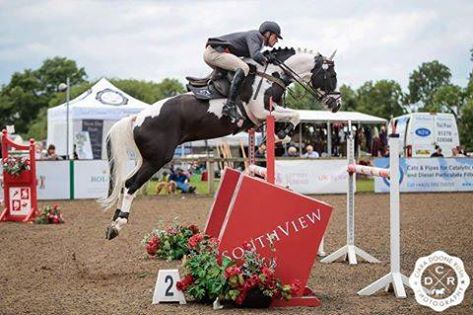Classical Dressage
The dressage , one (in French and English: dressage ), is one of the Olympic disciplines that form the riding . This discipline aims to develop a training horse by rational, methodical and balanced through which the rider gets it to perform all its orders with harmony, balance and activity. The horse becomes calm, resilient, agile and flexible, while it becomes more confident and attentive to the commands of the rider, with him coming to form a perfect couple. 2These qualities are manifested by: 3
The openness and regularity of the paces. - The harmony, lightness and ease of movements. - The lightness of the forehand and the engagement of the hind whose origin is due to a drive, always active. - Submission to the mouth with a full decontraction without tension or resistance.
The horse thus gives the impression to handle by itself. Confident and attentive, generous obey the directions of his rider, remaining absolutely right on all the moves in a straight line and adjusting its curvature to curved paths.
His walk is regular, open and loose. His trot is free, supple, regular, sustained and active. His canter is regular, light and cadenced. The hips should always show the slightest indication active rider and by their action, also encouraging all parts of the horse.
With its drive, always awake, and the flexibility of your joints, which paralyzes any resistance, the horse obeys willingly and without hesitation and responds to aid a calm and clear, showing a natural and harmonious balance both physically and mental.
In all his work, even at the stop, the horse must be "on hand". It is said that a horse is "in hand" when the neck is more or less raised and arched according to the degree and extent dressage or air meeting, and accepts the bridle with a light and soft contact and complete submission. The head should remain in a stable position and, as a rule, slightly ahead of the vertical, with a supple poll and in the highest point of the neck, and no resistance horse his rider.
Cadence is shown in trot and canter, and is itself the result of harmony that a horse shows when it moves with well marked regularity, impulsion and balance. Cadence must be maintained in the different exercises trot or canter and all variations of these winds.
The regularity of the paces is fundamental to Dressage.
History
The origins of the training date back from ancient times to the Middle Ages, when all official European chivalry began to practice some exercises with the intention of improving their horsemanship.
In its evolution over the centuries and concerns about further development in this discipline created what we now know as the high schools. were created Early Renaissance courts in three different styles: the Vienna high school Spanish ( founded in 1572), the Portuguese Marialva (founded by Philip IV in the seventeenth century) and the French Versailles (founded by Louis XIV in the seventeenth century) and later, the Cadre Noir of Saumur
In the first two control prevailed and the high degree of composure, while France was characterized by a lighter style and high pass. All these schools were created for cavalry officers perfeccionasen aprendiesen or mating.
In them, the classical tradition of dressage is considered as an art form. The traditions of the great masters who originated what is now known by dressage still kept alive today in the aforementioned schools, which are still in use, or in new schools, such as the Royal Andalusian School of Equestrian Art in Jerez , founded by Don Alvaro Domecq Romero , considering why one of the biggest drivers of dressage in Spain.
Horse Races
The horses of all breeds can practice and get the benefits of dressage practice entails. In top competition horses used are called the warm-blooded breeds, like Hanoverian (Hann), the Trakehner (trak), the oldenburguesa (Oldenburg), Dutch Warmblood (KWPN), Danish Warmblood (dwb ) and other northern and central Europe as they have, in general, excellent athleticism and a better constitution for performing dressage exercises, as the air extended.
The horses of other breeds are easier for other exercises. This is the case of baroque breeds horses, such as the Pure Spanish (PRE), the Lusitano (PSL), the Lipizzaner or Frisian. These horses are capable of meeting high and the air with greater ease than warm-blooded. They also have a reputation for learning more easily. The improvement in the breeding of these breeds, especially Spanish and Lusitanian experienced since the nineties of the twentieth century is allowing its presence in high-level international competitions is increasingly abundant.
The issue of race played an influential role in the competition. Many breeds breeders select their players constantly looking for a better horse for as what sports. Typical examples have in the Thoroughbred, which is the best for racing, the workhorse for the chair shot or French for the jump. In the XXI century, due to increasing demands for athletic horses dressage breeding lines for jumping competitions and dressage in European Warmblood breeds have approached a lot, being children of a common same stand a stallion in jumping and dressage others.
In the case of Spanish Thoroughbred, their skills become increasingly evident (as demonstrated in the World Equestrian Games in Kentucky 2010, the ensemble formed by Juan Muñoz Diaz and Fuego XII), which is a particularly suitable race for Dressage and High School. His nobility and intelligence, strength and plasticity that characterizes it, make animals of this breed the perfect companions for the High School practice with elegance and simplicity.
According to the ranking published by the World Federation of Sports Horse Breeders (WBFSH its acronym in English), 4 races best performers in official competitions of dressage FEI in 2010 were:
Dutch Warmblood (KWPN)
Hanoverian (Hann)
Danish Warmblood (DWB)
Oldenburg (Oldenburg)
Westphalian (Westphalia)
Holsteiner (Holst)
Purebred Spanish Horse (PRE)
Purebred Lusitano (Lusit)
Trakehner (Trak)
Swedish Warmblood (SWB)
Stresses the excellent performance of Iberian horses in 2010, confirming a clear improving trend for twenty years.
The competition
Table Regulations 2008 FEI Dressage devoted to categories of competition.
Basically, the competition is the horse to perform a series of exercises (reprise) in different airs (walk, trot and canter), based on the orders that gives its rider. The judge has the number of exercises performed on the dual track. This will give a score between 0 and 10 for each exercise. After finishing the reprise, the judge gives a whole notes, which are measured in the air, the drive, the submission and the rider's position and seat, correctness and effect of aids on his horse. These notes, along with some other note (eg long step in testing minors) have factor of two, which causes a doubling of its importance. Finally, there is an average of all the ratings of each judge. The combination that will get more than half of the test winner.
The competition begins in the preliminary levels, in which the judge wants to see freedom and balance by the rider. It is the role of coaches set the basis for future work. In early tests, the pair has only basic exercises at walk and trot.
The difficulty is advancing in a number of categories, ranging from testing to testing Fry Young Riders, to Children, Youth and Cadets. After these categories, there are two more. A lower degree of difficulty, the Middle and last, in which more than required level, called Grand Prix. This category is used in international championships and the Olympic Games . There reprises mandatory testing, in which horse and rider must perform a series of exercises in a specific order, and free trial or Kur, in which each rider choose your exercising their performance within those permitted by regulations FEI, to the sound of music of your choice. These tests are preferred by the public.
The track
Track Two sizes: small 40x20 m 60x20 m standard. Each has letters assigned to positions around the arena to specify where movements are made. The small head is used to lower levels of training. Its letters around the outside edge, starting with the entry point and moving to the right, are AKEHCMBF. Letters also mark locations in the center of the arena: Down the center line, are DXG, with X in the center.
World Championship
The Dressage World Championship tournament is the global maximum of dressage. It is held every four years since 1966 and since 1990 is held under the World Equestrian Games (JEM).
World Championships dressage
Individual Champions Team Champions
Year City Rider Country Horse Team Riders / Horses
1966 Bern Josef Neckermann Mariano J. Neckermann / Mariano R. Klimke / Dux H. Boldt / Remus
1970 Aachen Elena Petushkova Pepel E. Petushkova / Pepel Ivan Kizimov / Ichor Ivan Kalita / Tarif
1974 Copenhagen Reiner Klimke Mehmed R. Klimke / Mehmed L. Linsenhoff / Piaff K. Schlüter / Liostro
1978 Goodwood Christine Stückelberger Granat U. Schulten / Slibowitz Harry Boldt / Woycek G. Grillo / Ultimo
1982 Lausanne Reiner Klimke Ahlerich R. Klimke / Ahlerich G. Grillo / Galapagos U. Schulten / Madras
1986 Cedar Valley Anne-Grethe Jensen Marzog R. Klimke / Pascal G. Capellmann / Ampère Jo Hinemann / Ideaal H. Krug / Dukat
1990 Stockholm Nicole Uphoff Rembrandt N. Uphoff / Rembrandt S. Rothenberger / Ideaal AK Kroth / Golfstrom M. Theodorescu / Ganymede
1994 Hague Isabell Werth Special GP Gigolo I. Werth / Gigolo N. Uphoff / Rembrandt Balkenhol BK / Goldstern K. Rehbein / Donnerhall
ID ID Anky van Grunsven Free GP Bonfire
1998 Rome Isabell Werth Gigolo I. Werth / Gigolo N. Capellmann / Funny K. Rehbein / Donnerhall U. Salzgeber / Rusty
2002 Sherry Nadine Capellmann Farbenfroh N. Capellmann / Farbenfroh U. Salzgeber / Rusty K. Husenbeth / Piccolino AK Linsenhoff / Renoir
2006 Aachen Isabell Werth Special GP Gigolo I. Werth / Satchmo N. Capellmann / Elvis H. Kemmer / Bonapart H. Schmidt / Wansuela Luck
ID ID Anky van Grunsven Free GP Salt
2010 Lexington Edward Gal Moorlands Totilas HP Minderhoud / Nadine I. Schellekens / Sunrise A. Cornelissen / Parzival E. Gal / Moorlands Totilas
Olympic Discipline
This discipline was accepted into the Olympic Games in 1912 and the Olympic trials are the most advanced. This level of proof required more skill and concentration of horse and rider.
Olympic Champions
Olympics
Year Country Rider Horse
1912 Carl Bonde Emperor
1920 Janne Lundblad One
1924 Ernst Linder Piccolomini
1928 Carl-Friedrich Freiherr von Langen Draufgänger
1932 Xavier Lesage Taine
1936 Heinz Pollay Kronos
1948 Hans Moser Hummer
1952 Henri Saint Cyr Master Rufus
1956 Henri Saint Cyr Juli
1960 Sergej Filatow Absent
1964 Henri Chammartin Woermann
1968 Iwan Kisimow Igor
1972 Liselott Linsenhoff Piaff
1976 Christine Stückelberger Granat
1980 Elisabeth Theurer Mon Chérie
1984 Reiner Klimke Ahlerich
1988 Nicole Uphoff Rembrandt
1992 Nicole Uphoff Rembrandt
1996 Isabell Werth Gigolo
2000 Anky van Grunsven Bonfire
2004 Anky van Grunsven Salt
2008 Anky van Grunsven Salt



